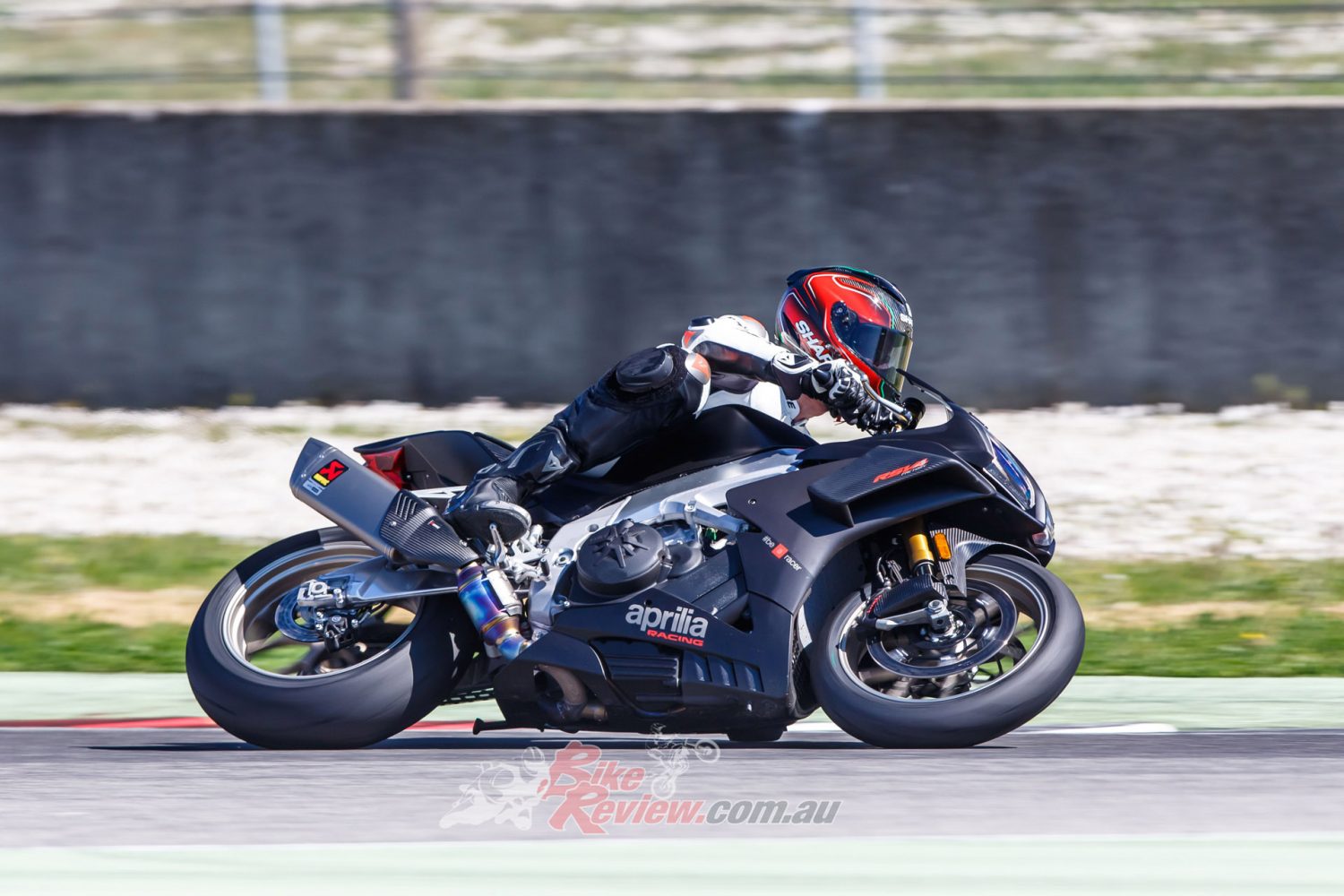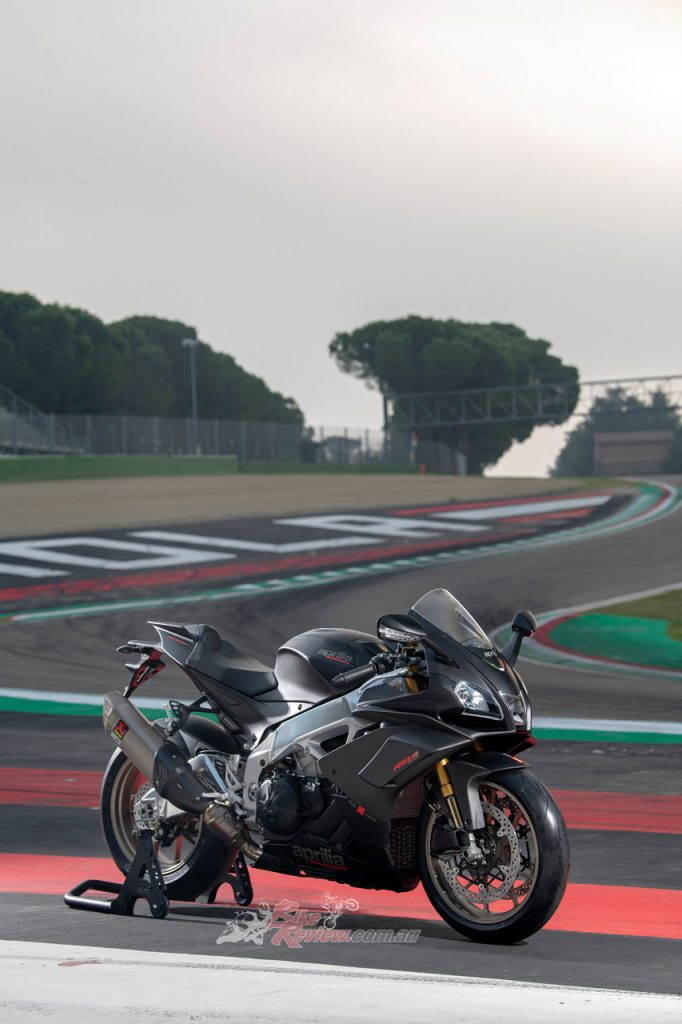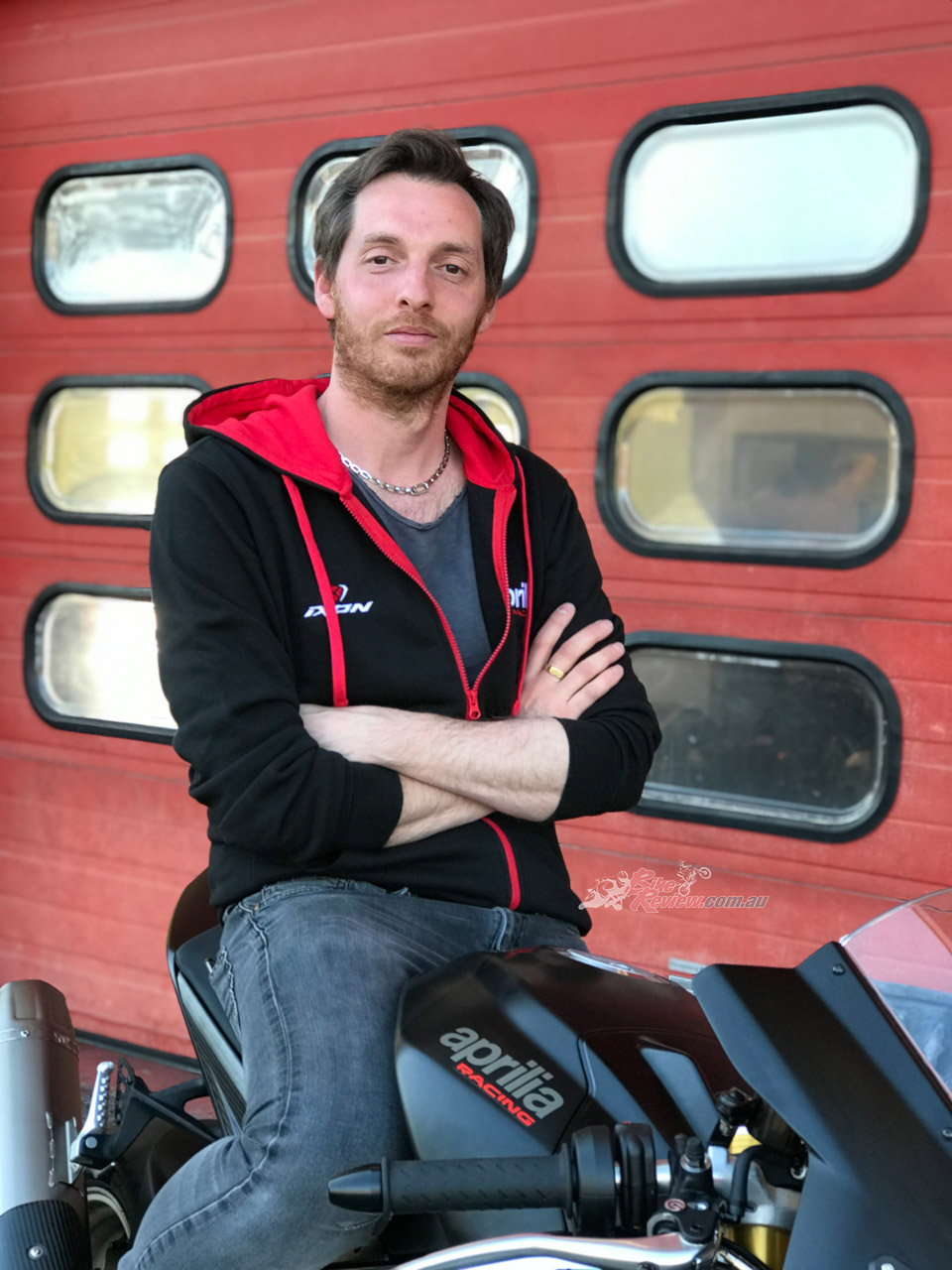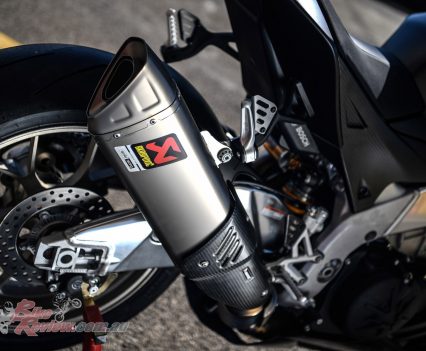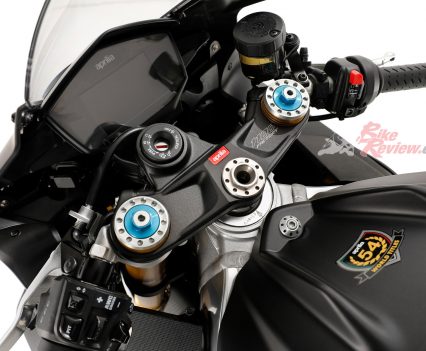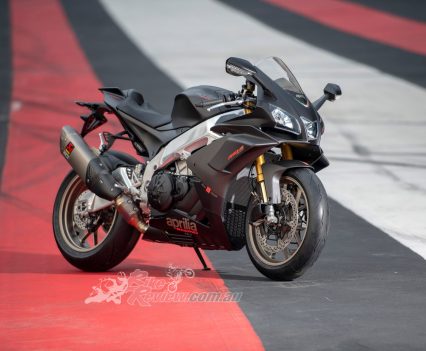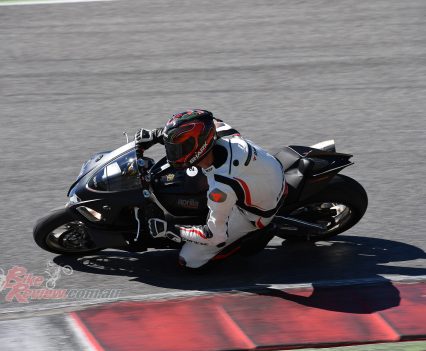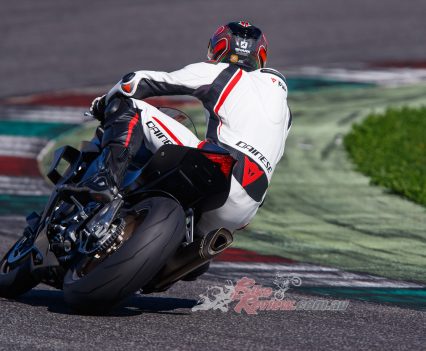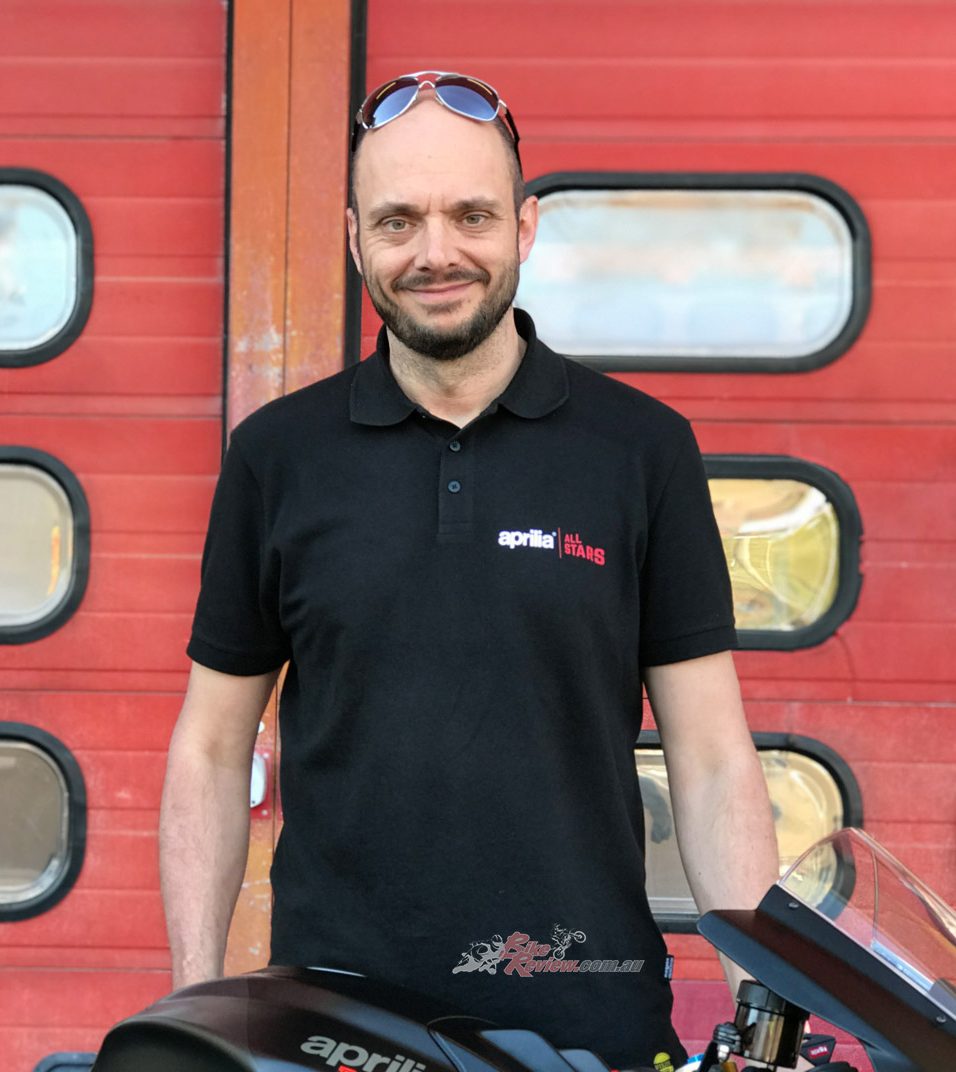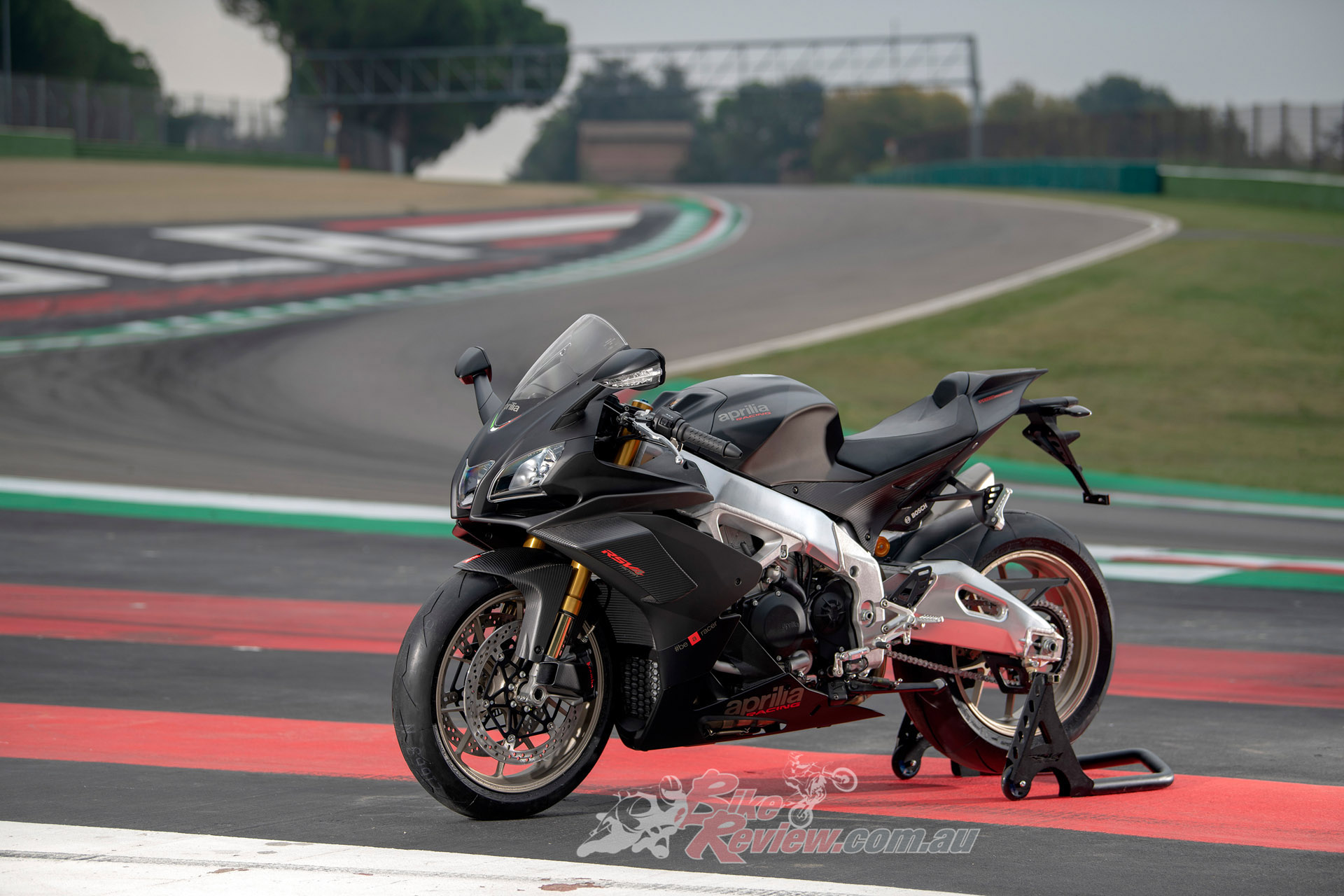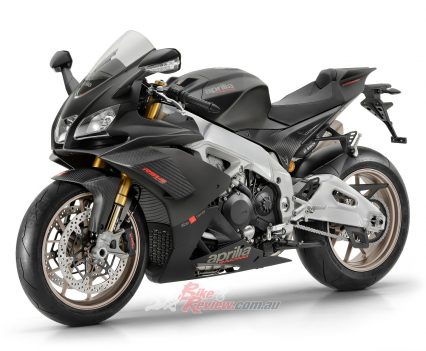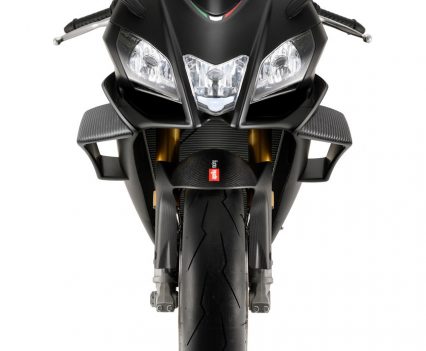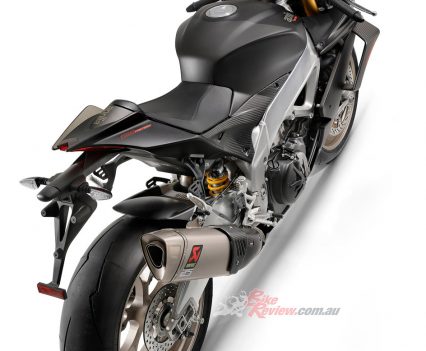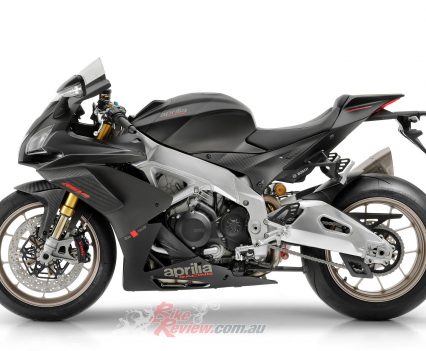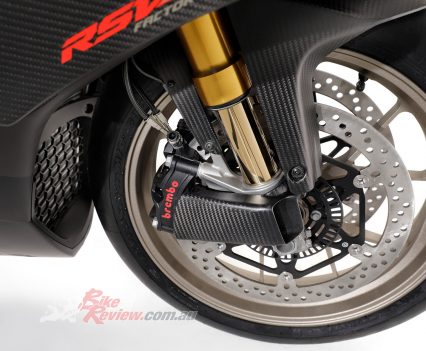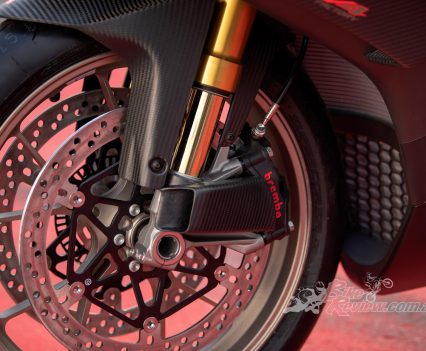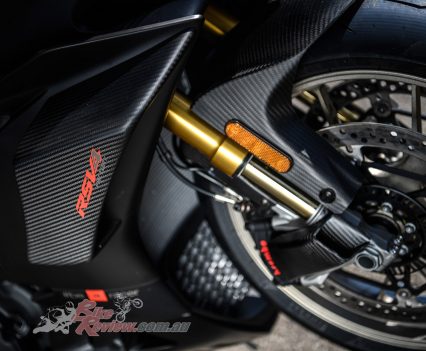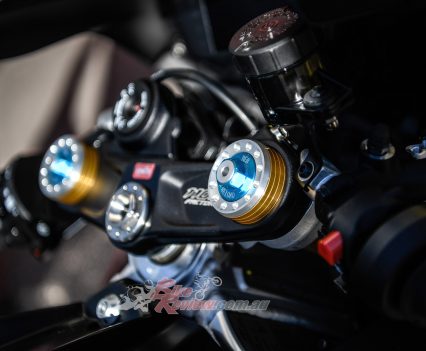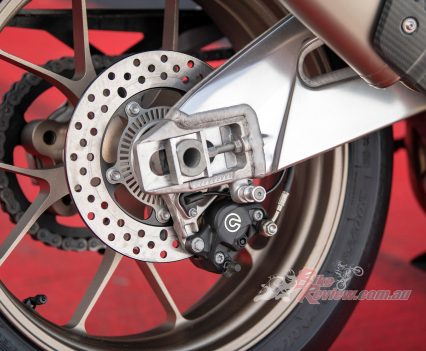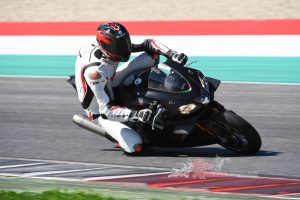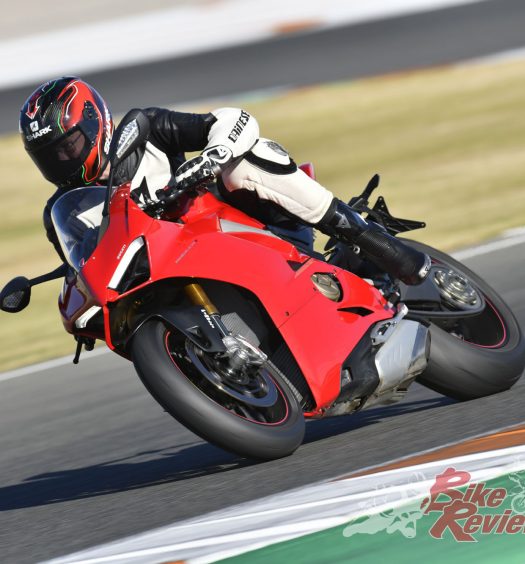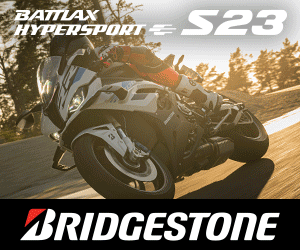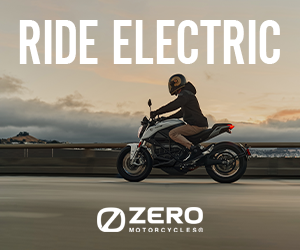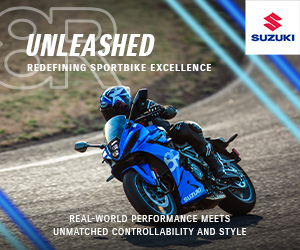After exiting WSBK, Aprilia decided to follow arch rivals Ducati and produce a high end, higher capacity road superbike by opening up the RSV4 1000. We visit Mugello to test the RSV4 1100 Factory... Review: Roland Brown Pics: Melagro
It has to be one of the most thrilling experiences on two wheels. I’m hammering over the brow of the hill on Mugello’s long pit straight, head tucked behind the screen of an RSV4 1100 Factory that is flat-out in top gear and still accelerating enthusiastically with a delicious V4 growl audible above the wind roar.
The circuit drops away and the Aprilia keeps on charging down the hill, staying rock solid as it leans slightly left across the track…
Then suddenly I’ve passed the 300-metre board, reached my trackside marker and squeezed the front brake lever, pushing myself back in the seat, bracing my neck muscles against the wind, and gripping the tank with my knees against the ferocious deceleration of the Brembo Stylema front brake calipers as I tread down four gears for the long right-hand turn of San Donato.
Lapping a famous MotoGP circuit in picturesque Tuscany certainly adds to the excitement, but you don’t need Mugello to make the RSV4 1100 feel mighty fast and exotic. Back in the pit garage, I check the Aprilia’s TFT console to find a recorded maximum speed of 324km/h, or 201mph.
The true speed was maybe 20km/h lower (and probably recorded by my diminutive French co-rider), but even so there’s no doubt that this revamped V4 is right up there with the world’s fastest streetbikes. It’s one of the most sophisticated and sweet-handling, too.
How much the Aprilia’s impressive stability at such high speed was aided by its revised chassis or the way its new MotoGP-style winglets pushed the front tyre into the track is impossible to say. What I do know is that this is the first RSV4, going right back to the original model of a decade ago, that I’ve happily ridden for several sessions on a dry racetrack without even feeling the need to adjust its suspension. Check out our review of the previous model here.
The RSV4 1100 Factory name reveals this bike’s most important development: its capacity increase from 999 to 1078cc. Exceeding Superbike racing’s capacity limit hints at a subtle shift in the Aprilia’s focus, away from the direct competition link that has dominated ever since 2009, when Max Biaggi won a World Superbike race in the RSV4’s debut year before taking the first of the bike’s three titles the following season.
“Until now, 1000cc has been the psychological limit for the RSV4 because riders have used the bike for racing,” says Aprilia’s product marketing chief Cristian Barelli. “Now we’re moving towards producing a premium product in terms of performance, style and materials. It’s more like the situation with supercars like Ferraris and Lamborghinis. They are not race-replica cars, they are luxury cars that can go very fast on a racetrack.”
Given the way arch rival Ducati’s Panigales have grown in capacity of late, that surely makes sense. The basic RSV4 layout of compact, 65-degree DOHC V4 engine in highly adjustable, aluminium beam-framed chassis is unchanged. Bore is up from 78 to 81mm, mirroring the Tuono’s increase of two years ago, with pistons reshaped to lift compression ratio to 13.6:1.
New intake cams, reprofiled throttle bodies, a remapped Magneti Marelli ECU and a new exhaust system with titanium Akrapovic silencer combine to increase maximum output by a handy 16bhp, to a claimed 214bhp (217PS) at 13,200rpm.
What’s arguably more important is the way that torque output is increased throughout the rev range, and by roughly 10 per cent all the way from 8000 to 13,000rpm, with the maximum of 122Nm arriving at 11,000rpm. Other engine-related changes include taller fifth and sixth gear ratios, again following the Tuono’s; and uprated cooling from a higher-flowing oil pump and twin oil jets for each piston.
Standard set-up of the multi-adjustable frame has been fine-tuned with tweaks to the steering head bushes and triple-clamps. There’s no change to the main frame’s mix of cast and extruded aluminium sections (bar the addition of a rubber insert to reduce noise), but the alloy swingarm is stiffened internally.
Specification of the multi-adjustable Öhlins suspension is also changed, to a TTX rear shock and an NIX front fork with 125mm of travel, which represents a 5mm increase. The RSV4 shape is familiar, and classy in its matt-black colour scheme, complemented by carbon front mudguard and sidepanels, and forged wheels anodised to match the Akro can. (Even so, I’d prefer brighter paintwork like that of the limited-edition RSV4 X.)
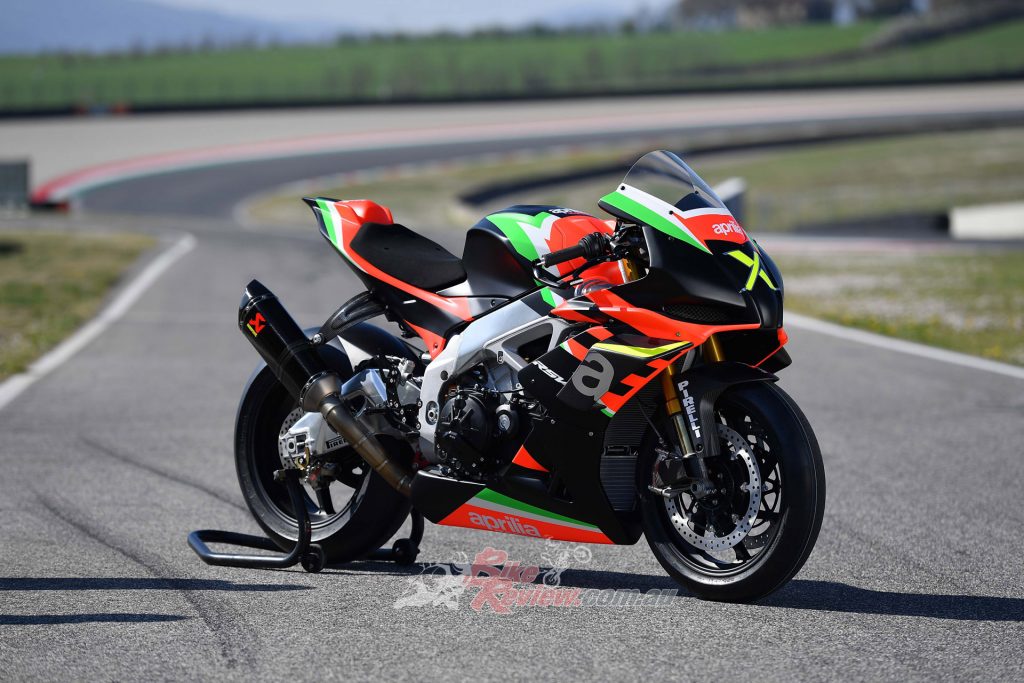
The super limited edition RSV4 X paint and decal scheme is much nicer on the eye than the RSV4 1100 Factory’s black.
Where this Factory differs is with its new carbon-fibre winglets, as developed on the RS-GP being raced in MotoGP. Aprilia say the winglets provide 8kg of downforce at 300km/h, and weigh only 142g apiece. The launch bikes were also fitted with optional carbon air-ducts to cool their new Stylema calipers, the latest, lightweight Brembo spec’ as also fitted to the Panigale V4.
Even with the ducts fitted they’re lighter than the old M50s, contributing – along with a smaller lithium-ion battery – to a 5kg reduced dry weight of 177kg, which keeps kerb weight just under 200kg.
2019 Aprilia RSV4 1100 Factory – The Ride
Climbing aboard the bike in the Mugello pit lane, checking out the unchanged TFT dash and heading out onto the track, it’s the RSV4’s traditional lack of size rather than weight that makes the first impression. As before, there are three riding modes (Sport, Track and Race), with subtly different levels of engine braking as well as power delivery.
The familiar APRC (Aprilia Performance Ride Control) electronics suite includes pit-lane limiter, cruise control and launch control, as well as the anti-wheelie and traction control that can be fine-tuned on the move. It all combines with the sweet throttle response to create a bike that in Track mode is as controllable as it is fast, and which helps me relearn the majestic, undulating Tuscan circuit with its numerous crests and blind turns.
Less helpful in the first session is the engine’s occasional tendency to find neutral going into a bend, which has me running wide a couple of times, and turns out to be caused by the gearlever being low.
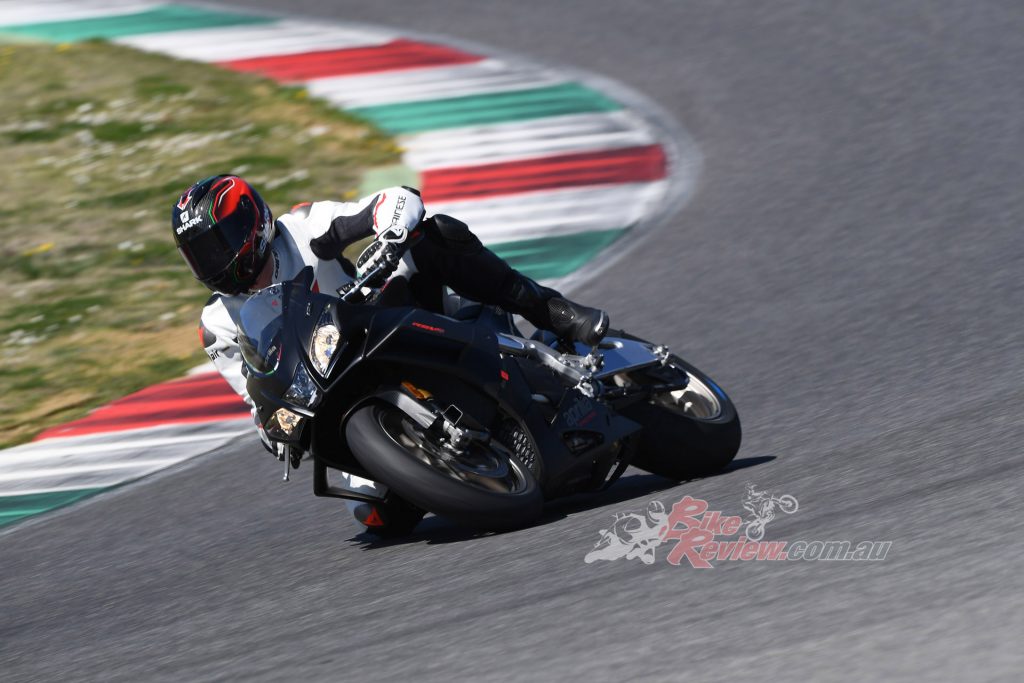
Roland says this is the forst RSV4 model he has tested that he didn’t need to touch a clicker on all day.
The biggest boost to lapping fast, though, is that sublimely flexible big-bore V4 engine. It takes me a few laps to figure it out. At first I’m using too many revs: second gear for the second chicane, the long Biondetti right-hander, and for a lap or two even the downhill Bucine left that leads back onto the pit straight. But the Aprilia revs so hard and fast that I’m struggling to get my foot under the gearlever before tagging the limiter at 13,600rpm and losing time.
The solution is simple: use the mid-range torque. The big V4 motor pulls so strongly and sweetly from 8000rpm or so that it’s much quicker as well as less effort to take those turns in third gear, concentrate on hitting the mostly late apexes and getting the power on smoothly, and let the extra grunt send the bike rocketing onto the following straights with its ultra-dependable traction control helping the sticky rear Pirelli Supercorsa SC1 deliver maximum drive, and the anti-wheelie keeping the front wheel pointing in the right direction.
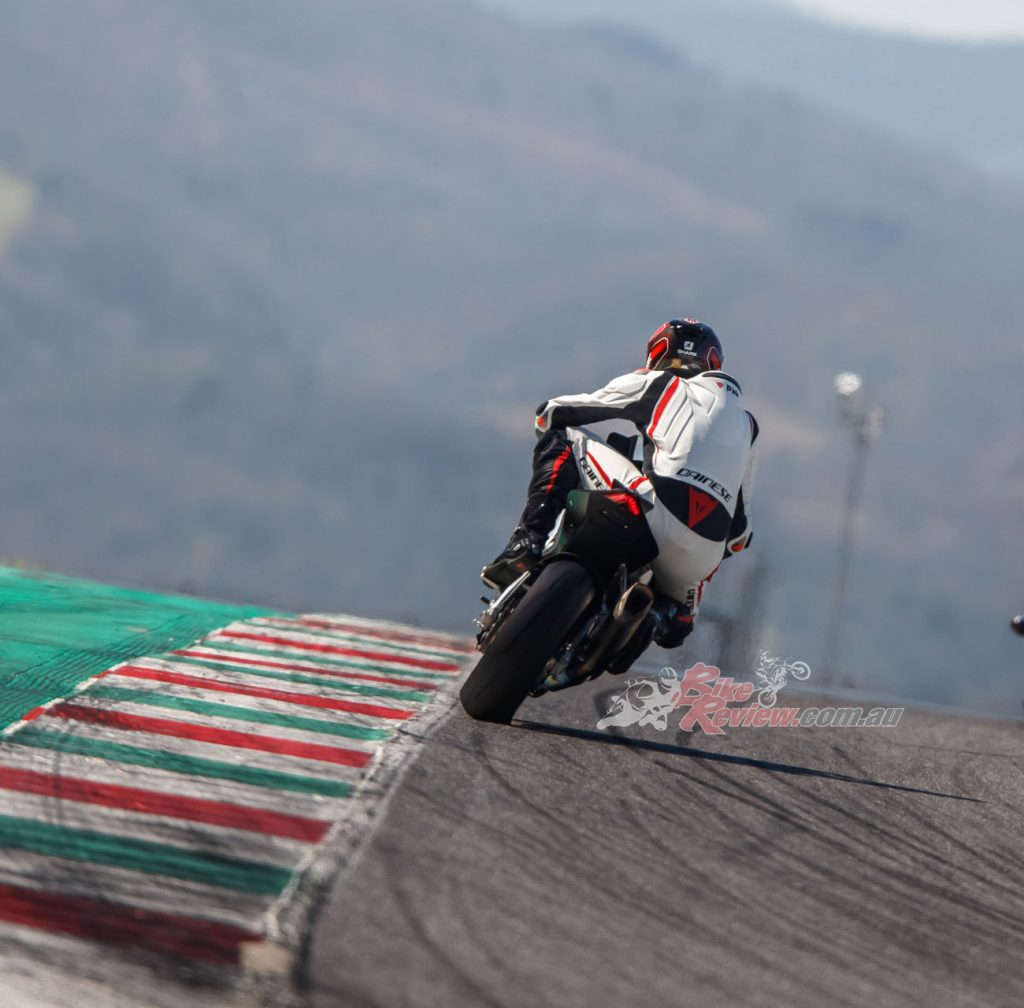
Laying black lines of sweet SC1 rubber from the fat 200-section tyre is unavoidable with 214hp on hand.
Stability is exceptional, notably better than that of the initially frisky RSV4 Factory that I recall riding at Misano a few years ago. Occasionally there’s a slight twitch as the bike rips onto the pit straight and I pull myself forward to help keep the front wheel down, but it’s nothing that makes me back off or even bother tweaking the adjustable Öhlins steering damper.
The Factory’s composure at super-high speeds further down that long straight is immense. How much that’s due to the winglets I’ve no idea, but if they’re useful anywhere it’s probably there. Cornering poise is also outstanding, though given more time I’d have tried raising the rear end a fraction, to help the Aprilia flick through the three chicanes even more quickly and effortlessly. The RSV4’s fine-tuning potential is vast and its base level very high.

Roland is super tall and so found the RSV4 1100 Factory cramped but at the same time he did not experience any fatigue on the bike.
As ever, the Aprilia can feel cramped for larger riders; I struggled to get my feet placed correctly on the ‘pegs at times. Slightly firmer suspension at both ends would have helped too but with time between sessions limited, and a smaller rider sharing my bike, I left it alone.
There’s no doubting the quality of the Öhlins units at each end, or their potential to deliver cutting-edge cornering ability when suitably fine-tuned. Aprilia considered following Ducati by moving to semi-active suspension, but decided against it, essentially because their testers found no lap-time advantage over conventional units (and the RSV4 has always been designed with lap times the priority).
Whether less skilled riders would be quicker with semi-active to help their set-up is a question that might one day lead to a different decision. Braking power is sensational and stability under hard stopping very good, marred slightly by the fact that several of Mugello’s turns are downhill. Into the steep Casanova right-hander, in particular, the rear end lifted and the bike twitched even when I squeezed the lever as gently as possible and sat right back in the seat.
On a hot day there was no brake fade with use, despite repeated hard slowing from high speed into San Donato. Who knows whether the carbon scoops made a significant difference, but they look suitably cool and weigh only 42g each – less than the Stylema calipers save over the previous M50s.
More laps to fine-tune the set-up – suspension, engine braking, riding position and ride height, if not the steering geometry or swingarm pivot position – would almost certainly have helped. That’s the thing about the RSV4, as true now as it was a decade ago: it’s a street-legal Superbike Racer, eligible capacity or not.
A little of the RSV4’s traditional direct link to the racetrack might have been lost with the extra cubes and Aprilia’s withdrawal from World Superbikes. But Noale’s commitment to racing is as strong as ever, and the RSV4 1100 remains what the firm’s Factory flagship has always been: a compact and fiercely competitive super-sports weapon. And this latest RSV4 combines that traditional focus with a new-found ease of use. It’s no roomier or more luxurious but it’s more powerful, gruntier, more stable, and even better suspended and braked.
Interview: Piero Soatti
(Aprilia Head of Bodywork and Chassis Engineering)
As well as being one of the world’s fastest and sweetest-handling superbikes, the 1100 Factory is among the purest and most rewarding to ride. Piero Soatti, Aprilia Head of Bodywork and Chassis Engineering talks development and the new RSV4 1100:
“The lap time is what guides all our development with the RSV4. It has always been that way, without compromise. Regarding engine capacity, we’ve had a really good experience with the Tuono V4 1100. The benefits are huge and our competitors had already increased their capacity, so we said, ‘Why not?’
“The very first RSV4 design in 2008 had a maximum target for the bore of 81mm, because at that time there was a discussion of whether that would be the maximum bore size [for World Superbike]. So the architecture of the engine was born with that. To enlarge it again we would need to change the gap between the pistons; it could be done but would be a big job.
 “With this engine it was easy to gain the power without adding dimensions or weight. The most difficult thing was cooling it. We did a lot of work on the oil circuit, double piston cooling jets, and higher flow oil pump. Will the RSV4 RR move to the 1100cc engine in future? I can’t say yes or no.
“With this engine it was easy to gain the power without adding dimensions or weight. The most difficult thing was cooling it. We did a lot of work on the oil circuit, double piston cooling jets, and higher flow oil pump. Will the RSV4 RR move to the 1100cc engine in future? I can’t say yes or no.
“With the chassis we started by changing the rear suspension, then we wanted more so a rapid tester said, let’s try with a stiffer swingarm. The Curvone [super-fast right-hander] at Misano was our test bench. Firstly we welded extra sections to the outside of the old arm, and found that more or less worked, so we studied the forces inside to give the same stiffness.
“Our relationship with the racing department is very good. We collaborate a lot with Massimo Rivola [Aprilia Racing CEO] and Romano Albesiano [Aprilia Racing Manager], who is my former boss [and led the original RSV4’s development team]. So although we are not in Superbike, we have that feedback from MotoGP.
“The carbon wings come from racing, and when we started we were a bit cynical about a road motorcycle having them. But last year we made the RSV4 Factory Works, the special from the race department, which had winglets. When we tested them our rider said they’re good, they bring some benefit in braking and stability. So they’re not just there for show”.
2019 Aprilia RSV4 1100 Factory Specifications
Price: $33,990 + ORC
Claimed Power: 159.6kW[214hp]@13,200rpm
Claimed Torque: 122Nm[92lbs-ft]@11,000rpm
Wet Weight: 199kg
Fuel capacity: 18.5L
Engine: Liquid-cooled 65-degree V4 16-valve DOHC, 1078cc, 81 x 52.3mm bore x stroke, 13.6:1 compression ratio, 48mm throttle-bodies, Marelli injection, two-into-one exhaust
Gearbox: Six-speed cassette type, quickshifter
Clutch: Wet multiplate slipper clutch, cable actuation
Chassis: Aluminium frame and swingarm
Rake: 24.5°
Trail: 103.8mm
Suspension: 43mm Ohlins NIX forks, fully adjustable, 125mm travel, Ohlins TTX shock, 120mm travel
Brakes: 330mm rotor(s) (f), Brembo Stylema monobloc calipers, Brembo master-cylinders, 220mm rotor (r), twin-piston Brembo caliper
Wheels & Tyres: Forged alloy 3.50 x 17in, 6.00 x 17in, Pirelli Diablo Supercorsa SC1 tyres, 120/70-17in, 200/55-17in
DIMENSIONS
Wheelbase: 14239mm
Seat height: 851mm
Ground clearance: N/A
Overall width: N/A
Overall Length: N/A
Overall height: N/A
Instruments: TFT
2019 Aprilia RSV4 1100 Factory Gallery
The Verdict | Review: 2019 Aprilia RSV4 1100 Factory

